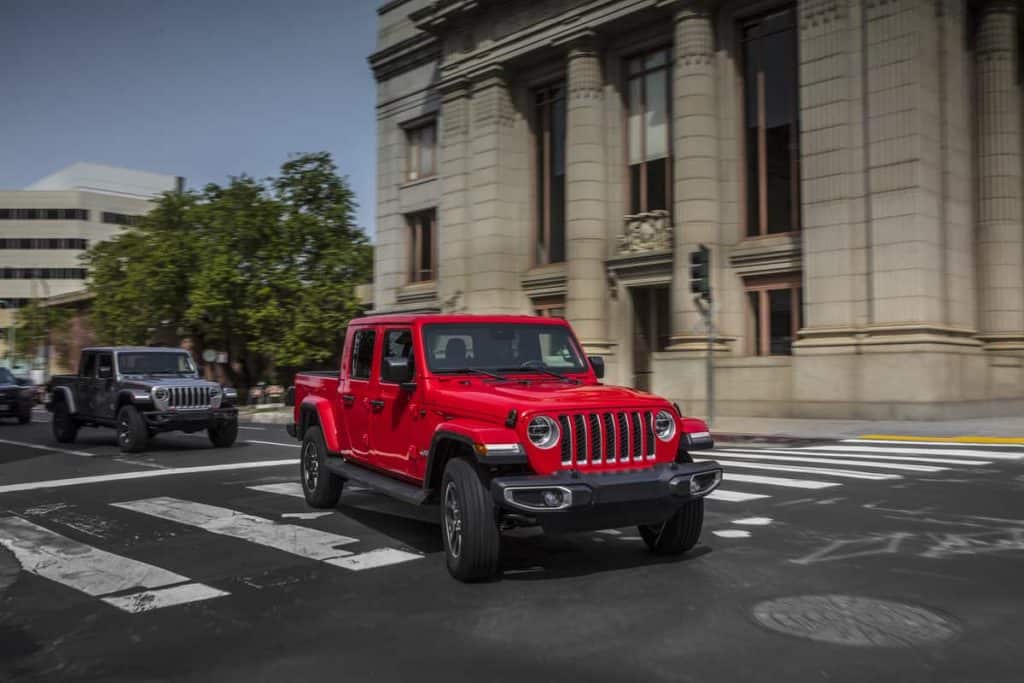Can the Jeep Gladiator be Flat Towed?
One of the most appealing factors about owning a Jeep is the freedom it provides. Jeep-owners are a bunch that are constantly seeking out opportunities for adventure, but sometimes, the Jeep can’t take you the whole way on its own. For those times when you need a bit more support outside of your Gladiator, you may need an RV or other vehicle to pull your Jeep along for the ride.
Can the Jeep Gladiator be Flat Towed?
Can the Jeep Gladiator be flat towed? Yes, the Jeep Gladiator can be flat towed. In fact, Jeeps are some of the best candidates for flat towing behind RVs.
There are many different types of towing methods that you can implement when bringing your Jeep along for adventures.
The most notable methods are dolly towing and flat towing. Although each method has its benefits, flat towing is by far the most cost-effective and intuitive method.
Below you’ll find more information on the benefits of flat towing and how to set up your Jeep Gladiator for a tow.
What is Flat Towing?
The vehicle being towed must have all four wheels touching the road for it to be considered a flat tow. This type of towing requires the use of a tow bar.
This tool is typically less expensive than a dolly or a flatbed, and is lighter – and therefore, more energy-efficient – than many other towing methods available.
Although it requires a few tools to be purchased upfront, it remains one of the cheapest options for towing a vehicle since these are only one-time purchases.
When you’re preparing for a flat tow, you need to consider all the available options for the necessary hardware:
- Self-Aligning Coach-Mounted Receivers: This receiver is adjustable from side-to-side. This is the best option for flat towing since it will correct itself even if the user has not set up the most effective hookup between the two vehicles. The advantage of this is that, since the receiver is hooked up to the rear of the coach, the towed vehicle’s front end is not weighed down by the tow bar, which relieves the pressure on the power train components.
- Self-Aligning Towed Vehicle-Mounted Receivers: This functions in essentially the same way that the coach-mounted receiver does, simply with a different point at which the receiver is mounted.
- Rigid A-Frame Tow Bar: These are a bit more complex to use and not recommended for beginners. This is because A-frame tow bars require much more precision in the driver of the RV or other towing vehicle. The bars are not self-adjusting and so do not move, so all adjustments must be compensated for by the driver.

How to Flat Tow a Jeep Gladiator
First, you need to check the weight of your Jeep and the towing capacity of your vehicle.
The weight of your Jeep may vary slightly depending on the trim you purchased, but there shouldn’t be any drastic differences. The average payload of a Jeep Gladiator is approximately 1700lbs.
Check your RV towing capacity to ensure that your Gladiator is compatible.
(You should not run into any problems since Jeeps are some of the most qualified SUVs for flat towing with RVs. Although the Gladiator is not an SUV. Trucks such as the Ram 1500 Laramie and the Chevrolet Colorado are also considered some of the best flat towing candidates.)
Now that you’ve confirmed your RV’s capabilities and your Jeep’s weight, you are ready to prepare for towing:
- Assemble your flat towing kit. You need:
- A base plate kit that fits your Gladiator’s model and year (many kits should fit all Gladiators, no matter what the model).
- Safety cables – purchase the right length or a coiled set of cables so they do not drag on the ground as you tow.
- Braking and wiring systems – purchase a set that you can install on the Gladiator so you don’t have to reinstall it every time you go to tow your vehicle.
- Lastly, check the height difference between where your Gladiator sits versus your RV. If your Gladiator sits too low or high in comparison to your RV, you may need a high-low adapter.
Once you have your kit, you’re ready to connect your vehicles.
Preparing a Gladiator for flat towing will not be much different from preparing a Wrangler since you’re focusing on the front end of the vehicle rather than the posterior.
- While the tow bar is mounted on the RV, unfold the tow bar and extend the arms outward.
- Position your vehicle within reach of the tow bar.
- Shift the transfer case into neutral. To do this, your key must be in the Accessory position. Proceed with the following steps:
- Press the brake pedal.
- Engage the parking brake.
- Shift the automatic transmission into Neutral, followed by shifting the transfer case into Neutral.
- Start the engine.
- Once the engine has been started, shift into Drive.
- Release the brake to confirm that the vehicle will not move.
- Shut off the engine and reposition the ignition to Off, instead of Accessory.
- Shift the automatic transmission into Park.
- Engage the parking brake once again.
At this point, you can attach the tow bar to the Jeep.
- Insert the two baseplate attachment tabs into the front of your vehicle.
- Remove the tow bar pins and clips.
- Position the lugs into place and secure them with the pins and clips you just removed from the tow bar. (After this step, both hooks should face the same direction, either outward or inward relative to their position on the vehicle. On motorhomes, these hooks should face downward.)
- Connect the electrical cables.
- Connect the air brake hose.
- Connect the emergency brake tether.
- Finally, lock the tow bar:
- On level ground, you can simply push the Jeep backward to lock it into place, or
- On sloped ground, you can gently move the RV forward to lock the tow bar.
Note that if you run the engine while you have the transmission in the Park position and, simultaneously, the transfer case in Neutral, you may inadvertently cause severe damage to the transmission.
The final step is to check that all lights and braking systems are functioning properly, and you’re ready to take off!
The Benefits of Flat Towing
There are many different types of towing methods, one of the most common (apart from flat towing), being dolly towing.
This method, as you may be familiar with, requires that the vehicle’s front wheels are elevated and positioned on top of a trailer.
Since most vehicles are front-wheel drive, this method can be beneficial, as you are not required to alter the drive shaft.
This is also advantageous to the condition of your drivetrain, as it eliminates the potential of contributing wear-and-tear to this vehicle component and so does not contribute to your mileage.
Still, despite the benefits, this is not the ideal method of towing for your Jeep Gladiator. Dollies are typically more expensive than flat-towing for starters and are also not suited for pulling rear-wheel drive vehicles.
This method also contributes to the uneven wear of the tires, whereas flat towing does the exact opposite. See the comparison table below for more information on the benefits of flat towing when matched up against dolly towing.
| Dolly Towing | Flat Towing |
| Can be used only for front-wheel drive vehicles | Wears all tires evenly since all four tires are on the ground at once |
| More expensive than flat towing | Cheaper than dollies |
| Depending on what state you’re driving in, you may be required to register and insure the trailer | Compatible with front- and rear-wheel drive vehicles |
| You will not have to insure or register the tow bar |
Most Popular Flat Towing Equipment
Last update on 2025-12-13 / If you click this affiliate link and make a purchase, we earn a commission at no additional cost to you.



